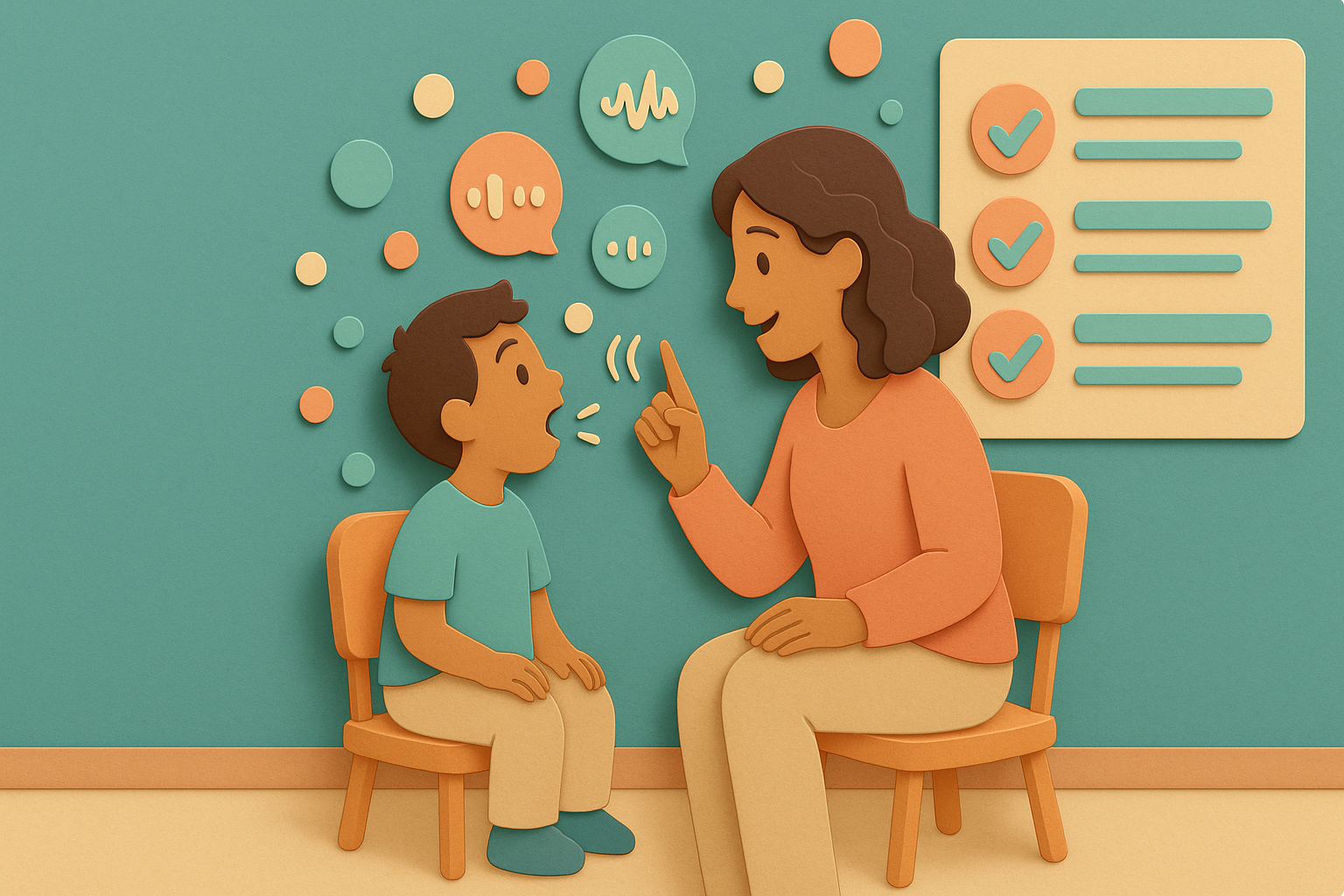
ndis speech therapy for stuttering
5 August, 2025
Introduction
Stuttering is a common speech disorder that disrupts the normal flow and rhythm of communication. This fluency disorder can make expressing thoughts and ideas difficult, especially for children developing early language skills. The challenges of stuttering may affect a child’s confidence and participation in daily life. Speech therapy, guided by skilled professionals, offers powerful tools to help overcome these difficulties and build stronger communication skills. Understanding the causes and support options is the first step toward helping children who stutter thrive.
Key Highlights
-
Stuttering is a fluency disorder affecting speech sounds, often beginning in childhood and impacting overall communication skills.
-
Speech therapy, especially through a qualified SLP (speech-language pathologist), is a proven way to improve stuttering and boost confidence.
-
The NDIS provides essential support and funding for children in Australia with stuttering or other communication disorders.
-
Early intervention and recognising risk factors, such as brain injury or family history, can lead to better speech outcomes.
-
Effective speech therapy techniques, including articulation therapy and language intervention activities, are tailored to each child’s specific needs.
-
Parents and healthcare providers play a key role in monitoring progress and ensuring access to the best treatment options.
What Is Stuttering?

Stuttering is a type of speech disorder often called a fluency disorder. It is marked by repeated syllables, pauses, or blocks that interrupt the smooth flow of speech. Children who stutter might repeat sounds or words, prolong certain speech sounds, or find themselves stuck trying to say a particular syllable. This disruption can affect how clearly thoughts are communicated.
Although the exact reasons for stuttering are not entirely clear, it’s often linked to a combination of genetic factors, differences in brain activity, and how the brain processes language. Stuttering involves more than just the repetition or prolongation of sounds—it can also lead to anxiety about speaking or avoiding specific words. Speech therapy can address these causes by focusing on improving articulation, helping children control their speech sounds, and supporting overall communication skills. So, what are the main causes of stuttering that speech therapy can address? Read on to find out. If you’re noticing early warning signs beyond stuttering, check out our guide on Early Signs your child might need speech therapy to know exactly when to reach out.
Common causes and risk factors for stuttering in kids
When looking at the root causes of stuttering in children, several factors stand out. Genetics play a strong role, with many children who stutter having family members with a similar fluency disorder. Neurological development, including how the brain processes language and forms speech sounds, can influence stuttering as well.
However, other risk factors can increase the chances of stuttering, such as:
-
Brain injury or traumatic brain injury, especially in young kids.
-
Certain medical conditions affecting speech and language development.
-
Family history or genetic factors linked to stuttering.
-
Environmental factors, like high stress or rapid language development.
Some children may also develop stuttering following a head injury or because of a health condition affecting brain function. By identifying these risk factors early, parents and healthcare providers can seek timely support from a speech-language pathologist. This proactive approach is often the best way to address stuttering before it severely impacts a child’s communication and social interactions.
Why Choose Speech Therapy for Stuttering?

Choosing speech therapy for stuttering means giving your child access to evidence-based, effective treatment options. When led by a certified SLP, this approach helps address the unique challenges of a communication disorder, with each session tailored to your child’s specific needs. Speech therapy improves fluency, builds confidence, and supports academic and social success.
Healthcare providers and speech therapist/ speech pathologist use proven techniques, including articulation therapy and language intervention activities, to support children in finding their voices. Wondering what the most effective speech therapy techniques are for stuttering? Let’s look at what parents should watch for next.
Want to know what NDIS can fund and how to use your plan for speech therapy? See Speech Therapy for Children — Funding Solutions via NDIS.
Early signs of stuttering parents should watch for
Recognising stuttering in its early stages can make a significant difference for your child. Not all children who repeat words or pause while talking have a fluency disorder, so knowing what to look for is crucial. Signs may include difficulty making eye contact, repeating speech sounds or syllables, and using a limited vocabulary compared to other kids in their age group.
Parents should be alert to the following:
-
Repeated syllables or sounds, such as “b-b-ball.”
-
Pauses in speech or blocks where your child seems stuck.
-
Visible struggle to produce certain words or sounds.
-
Frustration or avoidance when talking to others.
If you notice these patterns, especially as your child transitions between age groups or their vocabulary grows, early intervention with a speech-language pathologist can provide the best chance for improvement. So, at what age should a parent consider speech therapy for a child who stutters? Whenever concerns arise—early support is always beneficial.
When should a child be referred to a speech-language pathologist?
If you suspect your child has a speech disorder, timely referral to an SLP is the best way to start effective treatment. Waiting for stuttering to resolve on its own can lead to missed opportunities for progress, especially during critical periods of speech and language development. An SLP, or speech-language pathologist, is trained to assess, diagnose, and treat communication disorders.
Children should be referred if:
-
Stuttering has lasted for more than six months.
-
The child shows signs of frustration or anxiety about speaking.
-
Speech issues interfere with daily life or social interactions.
Whether your child’s stuttering is related to a health condition, a family history of fluency disorders, or seems to appear suddenly, seeking professional help is key. Speech therapy can begin at any age, but earlier is usually better for building lifelong communication skills.
NDIS and Accessing Speech Therapy Services in Australia
In Australia, the National Disability Insurance Scheme (NDIS) plays a vital role in supporting children with stuttering. The NDIS allows families to access speech therapy services tailored to specific needs, ensuring kids with a communication disorder get the right help. NDIS funding can cover sessions with a qualified healthcare provider, including a registered SLP.
Understanding how the NDIS supports children with stuttering can help you navigate the process. Next, let’s see exactly what the NDIS can offer for your child. Curious about online options? Read Can speech therapy be done online? to see if virtual sessions could work for your child.
How does the NDIS support children with stuttering?
The NDIS provides a flexible support system for children dealing with stuttering, offering both funding and access to specialised services. Through the NDIS, you can connect with approved therapy options that address your child’s communication disorder and individual health condition.
Support includes:
-
Funding for speech therapy sessions tailored to fluency disorders.
-
Access to healthcare providers specialising in stuttering.
-
Individualised plans to meet the child’s specific communication needs.
Here’s a summary in the table below:
|
NDIS Support Area |
What’s Included |
|---|---|
|
Speech Therapy Funding |
Financial coverage for therapy sessions with SLPs |
|
Assessment & Diagnosis |
Access to assessments for speech disorders and fluency concerns |
|
Individualised Plans |
Customised treatment plans to address specific needs |
|
Therapy Options |
Range of interventions: articulation therapy, language intervention activities |
|
Ongoing Review |
Regular updates to adapt support as your child’s needs change |
By partnering with the NDIS, families can ensure their children receive comprehensive care for stuttering, supporting both immediate and long-term communication goals.
How to Find the Right Speech-Language Pathologist

Choosing the right speech therapist can make all the difference when seeking effective treatment for stuttering. Look for a healthcare provider who is certified by reputable bodies such as ASHA (American Speech-Language-Hearing Association) or who has experience with fluency disorders at clinics like the Cleveland Clinic. Many qualified SLPs list their credentials and areas of expertise online, so start by searching for local providers with a background in treating stuttering.
To ensure the best results, ask about the therapist’s experience with your child’s age group and specific speech disorder. You may also want to consult with your healthcare provider for recommendations. Scheduling an initial evaluation allows you to discuss your concerns and learn about the speech therapy techniques the SLP uses. Finding the right match can help your child feel comfortable, supported, and motivated to make progress.
Your Therapy Roadmap
Once you’ve connected with a speech therapist, you’ll begin exploring treatment options tailored to your child’s needs. Sessions often start with an assessment of speech sounds, vocabulary, and specific fluency challenges. From there, the SLP will recommend a combination of articulation therapy, language intervention activities, and other speech therapy techniques designed to build confidence and improve communication skills.
Therapy sessions might include play-based exercises, repetition of target sounds, and strategies for managing stuttering in daily life. Consistent practice at home is usually encouraged to reinforce progress made in sessions. Over time, you can expect regular reviews to monitor improvement and adjust treatment as your child’s needs evolve. Want to know how sessions are typically structured and what to expect? The journey is collaborative, with you and your child working closely with the SLP every step of the way. If you’re unsure how to navigate funding, our post on Navigating NDIS Funding for Speech Therapy walks you step-by-step through the claims process.
Start Your Journey
Speech therapy for stuttering isn’t just for children—adults of all ages can benefit, even if they’ve struggled since childhood. Effective treatment empowers people to improve daily life and communication skills, regardless of age or how long stuttering has been present. Therapy also addresses related mental health conditions, such as anxiety or low self-esteem, often linked to long-term speech disorders.
If you or your child has been waiting to seek help, now is the time. Working with a speech therapist can transform your approach to communication and open doors to new opportunities. Remember, it’s never too late to make progress.
Take that first step today—book your consultation and start building a more fluent, confident future.
Frequently Asked Questions
Can stuttering be cured?
While stuttering is not always completely cured, many children and adults experience significant improvement with effective speech therapy. Treatment options focus on building fluency and confidence, helping individuals manage stuttering and communicate more comfortably in daily life.
How many speech therapy sessions are needed?
The number of speech therapy sessions required depends on factors like the severity of stuttering, age, and progress with treatment options. Some children improve quickly, while others may need ongoing support. Your SLP will tailor the plan to your child’s specific needs.
Is online stuttering therapy as effective as in-person?
Online therapy can be as effective as in-person therapy for stuttering, especially when delivered by a skilled SLP using proven methods. Both options help develop communication skills and achieve treatment goals—the best way depends on your family’s needs and preferences.
.svg)












